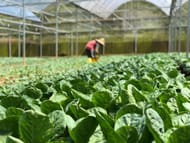If you're a fan of Deli salads, you might want to hold off on your next purchase. A new strain of E. coli has been discovered in some lettuce and other leafy greens.
The Centers for Disease Control and Prevention (CDC) suspects that this new strain of bacteria may be responsible for multiple outbreaks of foodborne illness in recent years, in particular, those linked to romaine lettuce and other leafy greens. The strain, known as REPEXH02, has caused dozens of hospitalizations and many cases of hemolytic uremic syndrome (HUS), which can cause kidney failure.
The strain, known as REPEXH02, has caused dozens of hospitalizations and many cases of hemolytic uremic syndrome, which can cause kidney failure.
Leafy Greens Linked to the Recent Foodborne Outbreak
The CDC's investigation has revealed that the REPEXH02 strain of E. coli likely emerged in late 2015. The strain has been classified as reoccurring, emerging, and persistent, indicating its ability to cause repeated outbreaks over time.
Whole genome sequencing was used to track the DNA of this strain and link related illnesses, providing a valuable tool for identifying connections between outbreaks.

Traditionally, E. coli outbreaks have been linked to the consumption of contaminated meat products, primarily from cattle sources. However, recent outbreaks have been associated with the consumption of leafy greens, with a significant proportion linked to romaine lettuce.
In fact, according to the CDC, 58% of recent illnesses were attributed to vegetable row crops, largely leafy greens.
Side Effects of REPEXH02 Strain of E. coli
According to the CDC, the new strain of E. coli that has been identified may cause certain symptoms if you've been infected. These symptoms may include:
1) Diarrhea
The affected individuals may experience watery or bloody diarrhea as a result of the infection.

2) Abdominal Cramps
In addition to diarrhea, abdominal cramps may also be present, causing discomfort in the stomach area.
3) Fever
Some people infected with this new E. coli strain may develop a fever, indicating an immune response to the infection.

Some symptoms of this infection may vary in severity depending on the individual and the extent of the infection. If you experience any of these symptoms after consuming potentially contaminated food, it is advisable to seek medical attention and inform your healthcare provider about your concerns regarding this new E. coli strain.
Contributing Factors That May Have Caused an Outbreak of the New E. coli Strain
One reason for the increasing number of outbreaks related to leafy greens is the rising demand for products like triple-washed bagged lettuce. Bagged salad mixes can serve as a favorable medium for E. coli growth.
Additionally, the expansion of agricultural activities near animal feedlots and dairies has increased the risk of contamination through flooding.

Ensuring the safety of leafy greens presents challenges, as they often do not undergo a "kill step" such as cooking that eliminates harmful bacteria.
Testing water sources used for irrigation is limited, and federal agencies responsible for food safety face restrictions when it comes to investigating feedlots and conducting thorough testing. This limitation hampers their ability to pinpoint the source of outbreaks and recall affected products promptly.

The identification of a new strain of E. coli behind recent foodborne illness outbreaks associated with leafy greens is a significant development in the world of food safety. The CDC's ongoing research and investigation are crucial for understanding the origins and persistence of this strain and working toward preventing future outbreaks.
It is essential for consumers, producers, and regulatory agencies to prioritize food safety and adopt comprehensive measures to ensure the well-being of the population.
